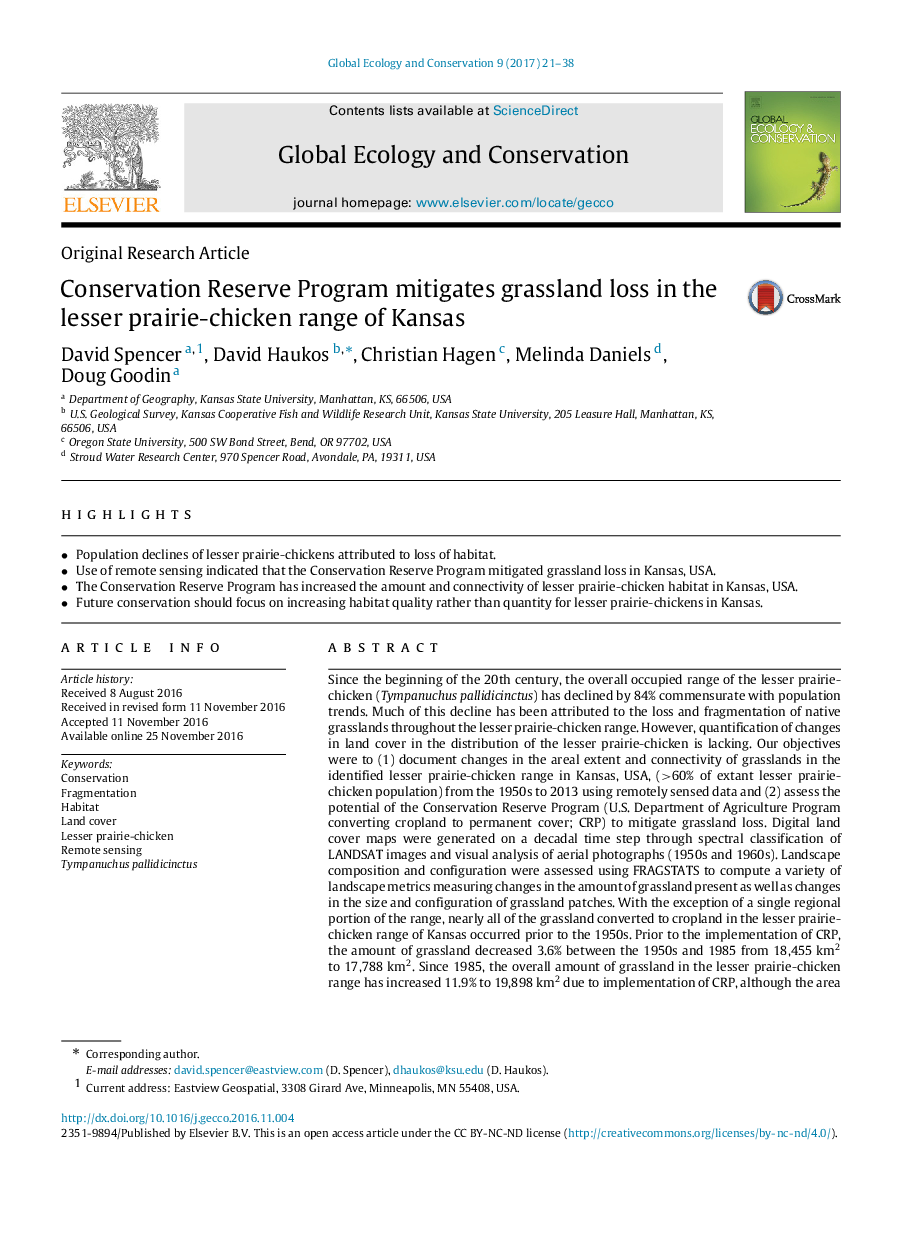| کد مقاله | کد نشریه | سال انتشار | مقاله انگلیسی | نسخه تمام متن |
|---|---|---|---|---|
| 5742426 | 1617658 | 2017 | 18 صفحه PDF | دانلود رایگان |
- Population declines of lesser prairie-chickens attributed to loss of habitat.
- Use of remote sensing indicated that the Conservation Reserve Program mitigated grassland loss in Kansas, USA.
- The Conservation Reserve Program has increased the amount and connectivity of lesser prairie-chicken habitat in Kansas, USA.
- Future conservation should focus on increasing habitat quality rather than quantity for lesser prairie-chickens in Kansas.
Since the beginning of the 20th century, the overall occupied range of the lesser prairie-chicken (Tympanuchus pallidicinctus) has declined by 84% commensurate with population trends. Much of this decline has been attributed to the loss and fragmentation of native grasslands throughout the lesser prairie-chicken range. However, quantification of changes in land cover in the distribution of the lesser prairie-chicken is lacking. Our objectives were to (1) document changes in the areal extent and connectivity of grasslands in the identified lesser prairie-chicken range in Kansas, USA, (>60% of extant lesser prairie-chicken population) from the 1950s to 2013 using remotely sensed data and (2) assess the potential of the Conservation Reserve Program (U.S. Department of Agriculture Program converting cropland to permanent cover; CRP) to mitigate grassland loss. Digital land cover maps were generated on a decadal time step through spectral classification of LANDSAT images and visual analysis of aerial photographs (1950s and 1960s). Landscape composition and configuration were assessed using FRAGSTATS to compute a variety of landscape metrics measuring changes in the amount of grassland present as well as changes in the size and configuration of grassland patches. With the exception of a single regional portion of the range, nearly all of the grassland converted to cropland in the lesser prairie-chicken range of Kansas occurred prior to the 1950s. Prior to the implementation of CRP, the amount of grassland decreased 3.6% between the 1950s and 1985 from 18,455 km2 to 17,788 km2. Since 1985, the overall amount of grassland in the lesser prairie-chicken range has increased 11.9% to 19,898 km2 due to implementation of CRP, although the area of grassland decreased between 1994 and 2013 as CRP contracts were not renewed by landowners. Since 1986 grassland in Kansas became more connected and less fragmented in response to the CRP. While the CRP has been successful in increasing grassland quantity and connectivity throughout the lesser prairie-chicken range in Kansas, offsetting loss of grassland since the 1950s, abundance and occupied range of lesser prairie-chickens has declined since the 1980s, suggesting that habitat quality is the principal factor influencing population demography of the species. Although the CRP is contributing to conservation actions for lesser prairie-chickens, efforts to improve habitat quality throughout the range of the lesser prairie-chicken are likely necessary to meet management goals. Continuation of the CRP faces an uncertain future in the face of rising commodity prices, energy development, and reduction in program scope, leaving open the possibility that these areas that have created habitat for lesser prairie-chickens could be lost.
Journal: Global Ecology and Conservation - Volume 9, January 2017, Pages 21-38
